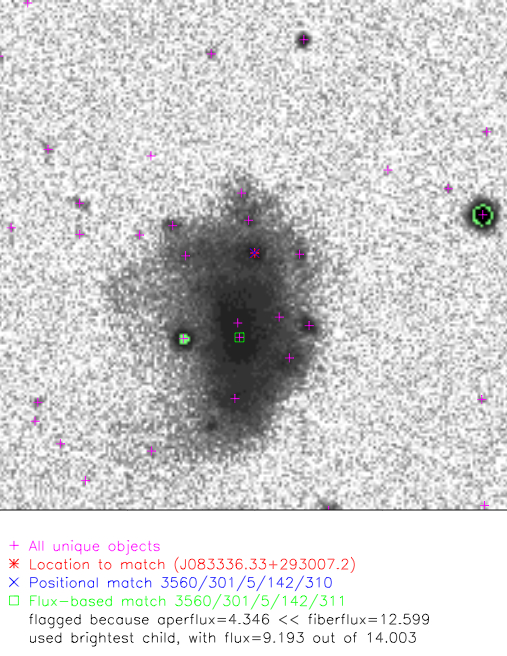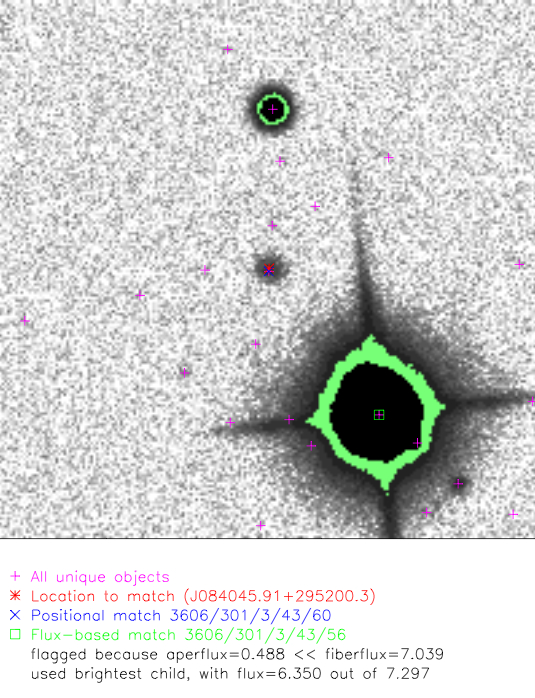Matching Photometry and Spectra
Overview
This page details how we determine which photometric objects match each spectrum. This task is nontrivial because the original runs used to target the SDSS spectra differs in many areas from the "primary" runs covering thus areas in the final data set. Even in those cases where the primary and targeting runs were the same, the photometric data has since been reanalyzed, and object detections and identifier have changed.
There are two versions of matching photometry for each spectrum: a positional match within 2 arcsec, and a flux-based match that tells you which object contributed the most light to the spectrum. These two matches differ about 0.5% of the time.
Position-based matches are stored in the spectroscopic catalog as bestObjID, and are most appropriate for spectrophotometry and for sources known to be stars. bestObjID is the "default" value. Flux-based matches are stored as fluxObjID, and can be superior if you primarily want redshifts of galaxies; in particular, they recover a number of nearby galaxy much better than the position-based match.
If you know for a fact that the spectrum you are interested in is of a point source (e.g. it is a star), then the position-based matches are best; that is, in such cases, the flux-based match is unlikely to be appropriate and in some cases can be incorrect (for example M stars in close pairs with bluer stars). However, many in such cases, if the position-based match and flux-based match disagree (fluxObjID != bestObjID) then the photometry and astrometry of the position-based match are incorrect and should be used with great caution.
Position-based matches
Position-based matches are the default matches. They are particularly important to use if you are primarily interested in the fiber fluxes, for example for spectrophotometry. In addition, if you are certain that your sources of interest are point sources, the position-based match is virtually always the right choice.
The position-based match simply finds the primary photometric object closest to the location of the spectrum within 2 arcsec. Note that for some number of objects, there is no such match (either the target object does not exist in the latest version of the imaging at that location, or the original target was a "sky" fiber).
In the flatfiles, the information about this match is stored in the photoMatchPlate file, and the detailed photometric information compiled in the photoPosPlate file.
In the CAS database, the objID of the position-matched photometric object is stored in bestObjID in the specObj tables.
Flux-based matches
The flux-based match is usually appropriate and typically more accurate for large, nearby galaxies. In particular, the latest photometric pipeline version deblends parent objects into children differently than the version used for targeting. Therefore, the spectrum we took of a galaxy might be significantly away from the location that we now deem to be the "center." The "flux-based"matches recover many such cases.
The flux-based match is determined as follows:
- For spectra that have no position-based match, we find the primary imaging field that contains the location of the spectrum. If there are no detected pixels at the location of the spectrum (that is, if it is not contained in a parent object) then the object is unmatched. Such objects typically result from sky fibers or from transient objects such as satellites, in cases where the primary imaging field in the final photometric catalog differs from the original field used to target the spectroscopy.
- Some spectra with no position-based match nevertheless fall within the boundaries of some "parent" object. In these cases, we perform 3 arcsec aperture photometry in the r-band at the location of the spectrum, using the atlas images of the parent and all of its children. We choose the child that contributes the most flux to the parent as the flux-based match, and store its object id as the
fluxObjIDassociated with the spectrum. - Finally, for spectra with a position-based match, we compare the 3 arcsec fiber flux with a 3 arcsec aperture flux based on the radial profile measured by
photo. The fiber magnitude is based on the parent atlas image, whereas the radial profile is calculated using only the child atlas image. Therefore, in cases where our aperture flux is less than 50% of the fiber flux, it signifies that some other child may have contributed more light to the fiber than the position-matched child. In such cases, we perform aperture photometry on the atlas images of the children and select the child with the most flux as the flux-based match, and store its object id as thefluxObjIDassociated with the spectrum.
About 0.5% of all spectra have flux-based matches that differ from the position-based matches. Typically, half of these are cases where the photometry is irretrievably bad in some way (such as a long satellite trail or airplane). The other half are cases where by-eye the flux-based match appears more appropriate; that is, where the redshift of the spectrum should be associated with the flux-based match in the photometric catalog.
In the flatfiles, the information about the flux-based match is stored in the photoMatchPlate file (the columns with the "flux" moniker), and the detailed photometric information compiled in the photoPlate file.
In the CAS database, the objID of the flux-based matched photometric object is stored in fluxObjID in the specObj tables.
Examples of flux-based matching
Below are shown two illustrative examples, one (A) a "success" of the flux-based matching, and the other (B) a "failure".
In Example A, we targeted the HII region of a nearby galaxy (marked with a red star at center). This spectrum matched a detected object in the final photometric catalog within 2 arcsec, yielding a position-based match (marked with a blue cross). However, most of the light at that location is actually contributed by the galaxy as a whole, in particular the child whose center is shown as the green box. Thus, the "flux-based" match is to the child that basically corresponds best to the galaxy, and this is normally the match one would want. (Of course, sometimes you actually do just want the position-based match, which we therefore also provide.
In Example B, we targeted a galaxy (marked with a red star at center) that happens to be close to a very bright star. The position-based match correctly finds the match in the final photometric catalog. Because photo's deblender can misbehave in cases like this, most of the light from this galaxy is actually assigned to the bright star, not to the galaxy. Thus, the flux-based match is to the bright star, which is not appropriate. However, in cases such as this, the position-based match is of limited use in any case, because the photometry of the galaxy in question is clearly highly flawed.
Other cases exist where the flux-based match does unexpected things (such as for passing satellites accidentally targeted for spectroscopy). In most such cases, achieving a meaningful and scientifically useful match to a quality photometric object is in fact impossible.
Occasionally flux-based matching fails in cases where the photometry is actually correct. Typically this occurs for sources of unusual color that have close neighbors.




